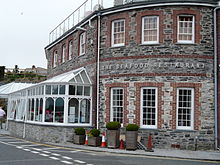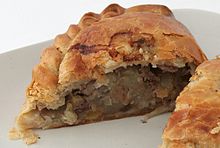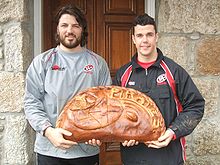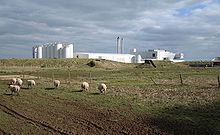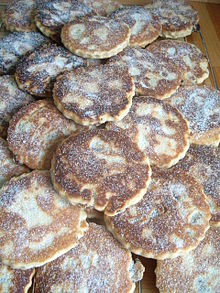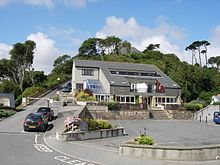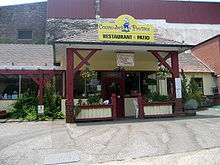- Cornish cuisine
-
This article is part of a series on British cuisine  Regional cuisines
Regional cuisines- English cuisine
- Scottish cuisine
- Welsh cuisine
- Gibraltarian cuisine
- Cornish cuisine
- Irish cuisine
Overseas/Fusion cuisine Britain portal
Britain portalCornish cuisine encompasses the cooking styles, traditions and recipes associated with Cornwall. It has been heavily influenced by the geography of the county as well as its social history.
Being a peninsula, fish dishes form a major part of the historical and modern recipes in Cornwall, with the fishing industry playing a major part in its economy. The iconic dish of Cornwall,[1] the pasty, has its roots in the other historical industry within the county, this being mining.
Certain Cornish food dishes have been granted protected geographical status under EU law, ensuring that they can only be labelled and marketed as "Cornish" if they are produced and mainly sourced within Cornwall.[2]
Cornwall has influenced and been influenced by other British cuisine, as well as having similarities with the cuisine of its neighbour, Devon.
Contents
Dishes
Cornwall has a strong culinary heritage. Surrounded on three sides by the sea amid fertile fishing grounds, Cornwall naturally has fresh seafood readily available; Newlyn is the largest fishing port in the UK by value of fish landed.[3]
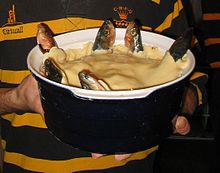 Stargazy pie with sardines looking skywards
Stargazy pie with sardines looking skywards
Traditional dishes in the Lizard Peninsula are described in a pamphlet published in 1980. These include breakfast of "gerty milk" (bread and milk) with tea or cocoa; pasties made of pastry, turnip, potatoes, beef and onion; boiled beef; squab pie of apples, onions and salt pork; "scrowled pilchards" (grilled over the fire on an iron plate); and "heavy cake".[4]
Cornish food and drink was promoted in the Houses of Parliament in April 2009 following intervention from Mark Prisk MP, then Shadow Minister for Cornwall, as part of the Commons plans for a South West regional food week.[5]
Larger commercial producers of characteristically Cornish products include the bakers Ginsters and Warrens Bakery, and the creameries Davidstow Creamery and Rodda's of Scorrier.
Fish dishes
Television chef Rick Stein has long operated a fish restaurant in Padstow for this reason, and in 2006 Jamie Oliver opened his second restaurant, Fifteen Cornwall, in Watergate Bay near Newquay. MasterChef host and founder of Smiths of Smithfield, John Torode, in 2007 purchased Seiners in Perranporth. One famous local fish dish is Stargazy pie, a fish-based pie in which the heads of the fish stick through the piecrust, as though "star-gazing". The pie is cooked as part of traditional celebrations for Tom Bawcock's Eve.
Pasties
Main article: PastyCornish Pirates (senior XV of Penzance & Newlyn RFC) players display a giant pasty which was paraded as part of the 2009 St. Piran's Festival at Camborne, Cornwall
Cornwall is perhaps best known though for its pasties, a savoury baked dish made from pastry. Today's pasties usually contain a filling of beef steak, onion, potato and swede with salt and white pepper, but historically pasties had a variety of different fillings. "Turmut, 'tates and mate" (i.e. Turnip, potatoes and meat) describes a filling once very common. For instance, the licky pasty contained mostly leeks, and the herb pasty contained watercress, parsley, and shallots.[6] Pasties are often locally referred to as oggies. Historically, pasties were also often made with sweet fillings such as jam, apple and blackberry, plums or cherries.[7] The Pasty Shop[8] and West Cornwall Pasty[9] are just two Cornish chains that have popularised traditional oggies around the UK.
Meat pies
Squab pie is a traditional dish from South West England, with early records showing it was commonly eaten in Cornwall, Devon and Gloucestershire. Although the name suggests it should contain squab (young domestic pigeon), it in fact contains mutton and apples. The pie has become popular around the world, though outside South West England, it generally does contain pigeon.
In recent times Ginsters bakery has become a large-scale producer of meat pies.
Dairy products
The wet climate and relatively poor soil of Cornwall make it unsuitable for growing many arable crops (e.g. wheat and rye).[citation needed] However, it is ideal for growing the rich grass required for dairying, leading to the production of Cornwall's other famous export, clotted cream. This forms the basis for many local specialities including Cornish fudge and Cornish ice cream. Cornish clotted cream is protected under EU law,[10] and cannot be made anywhere else. Its principal manufacturer is Rodda's, based at Scorrier.
- Cheese
Yarg is a semi-hard cow's milk cheese made in Cornwall. Before being left to mature, this cheese is carefully wrapped in nettle leaves to form an edible, though mouldy, rind. The texture varies from creamy and soft immediately under the nettle coating to a Caerphilly cheese-like crumbly texture in the middle. Modern production is at Pengreep Farm near Truro, by Lynher Dairies from an old recipe. Lynher Dairies also make Cornish Garland and Tiskey Meadow. Menallack and Nanterrow cheeses are made at Menallack Farm near Penryn.[11] Davidstow and Cathedral City Cheddar cheeses are produced at Davidstow by Dairy Crest, using water ultimately from St David's Holy Well, next to the parish church. St Erth was the site of a large creamery operated by United Dairies: this was responsible for processing a large quantity of milk produced in Penwith. Cornish Blue is a cheese made by the Cornish Cheese Company at Upton Cross and was recognised in December 2010 as the winning cheese in the World Food Awards.[12]
Cakes, sweet dishes and fruit
Local cakes and desserts include Saffron cake, Cornish heavy (hevva) cake, Cornish fairings biscuits, figgy 'obbin, scones (often served with jam and clotted cream) and whortleberry pie.[13][14][15] Baking cakes using yeast is more common here than in the rest of England. The Cornish Gilliflower is a variety of apple tree found at Truro in 1813 which was afterwards grown commercially. Various fruit trees can be grown in Cornwall but it is not particularly suitable for this. Whortleberries and blackberries can be gathered in some rural areas and homegrown produce can be used for jam-making or puddings.
Alcoholic beverages
There are many types of beers brewed in Cornwall – those produced by Sharp's Brewery, Skinner's Brewery and St Austell Brewery are the best-known – including stouts, ales and other beer types. There is some small scale production of wine, mead and cider. Spingo (meaning strong beer in Old English) is a generic name for a collection of beers brewed solely in the brewery of the Blue Anchor Inn in Coinage Hall Street, Helston. Cider was traditionally made for farmworkers but Cornwall is not particularly suited to apple growing. Healey's Cornish Cyder Farm near Truro brews and sells its own cider, brandy and country fruit wine produced on site.
- Australia
A boutique brewery operation in South Australia, Copper Coast Wines, produces traditional Cornish Swanky beer, a bottle conditioned beer, for the biennial Copper Coast region Kernewek Lowender Cornish Festival,[16] held in May in alternate (odd numbered) years. The name Swanky Beer appears to refer to a Cornish home-brew. During the 19th century, many Cornish miners emigrated to the Copper Triangle region of South Australia to work in the copper mines at Moonta. They brought local traditions, such as Cornish pasties and home brewed beer they termed "Swanky beer",[17] which was brewed from ingredients including: malted barley, hops, yeast, brown sugar, ginger, raisins and soft rainwater. It was put into beer bottles with the tops tied down with twine and stored in the coolest place in the house until ready. It was served on festive occasions, such as Easter, Midwinter's Night (Bonfire Night) and Christmas.
Overseas
Australia
Cornish food, like the Cornish pasty, is still popular amongst the Cornish Australian communities. Former premier of South Australia, Don Dunstan, once took part in a pasty-making contest. Swanky beer and saffron cake were very popular in the past and have been revitalised by Kernewek Lowender and the Cornish Associations.[18]
In the 1880s Henry Madren Leggo, whose parents came from St Just, Cornwall, began making vinegar, pickles, sauces, cordials and other grocery goods based on his mother’s traditional recipes. His company, now known as Leggo's, is wrongly believed by many to be Italian.[19]
United States
In Cornish American communities some aspects of the cuisine are derived from Cornwall. At Mineral Point, Wisconsin, it is claimed that authentic Cornish food, such as pasties and figgyhobbin, are served[20] and Cornish pasties are sold at ex-Cornish mining towns in America. The city of Grass Valley, California, holds St Piran's Day celebrations every year, which along with carol singing, includes a flag raising ceremony, games involving the Cornish pasty, and Cornish wrestling competitions.[21]
See also
References
- ^ "Cornish pasties can’t be pirated". DEFRA. 22 February 2011. http://ww2.defra.gov.uk/news/2011/02/22/cornish-pasties-can%E2%80%99t-be-pirated-3/. Retrieved 25 March 2011.
- ^ "EU Protected Food Names - UK registered names". DEFRA. http://www.defra.gov.uk/foodfarm/food/industry/regional/foodname/products/registered/index.htm. Retrieved 25 March 2011.
- ^ "Fishing Industry Leaders Back Objective One Investment". The Objective One Partnership. 30 August 2005. http://www.objectiveone.com/client/media/media-611.htm. Retrieved 23 March 2011.
- ^ Meneage and Lizard Oral History Group (ed.) (1980) Traditional Life in the Far South West. [N. pl.]: the Group; pp. 15-20
- ^ Laurie, Stocks-Moore (27 April 2009). "Chester businessman’s campaign to get Cornish pasties into Parliament". Chester Chroniclee. http://www.chesterchronicle.co.uk/chester-news/local-chester-news/2009/04/27/chester-businessman-s-campaign-to-get-cornish-pasties-into-parliament-59067-23484216/. Retrieved 24 March 2011.
- ^ http://www.alanrichards.org/cornish3.htm - Cornish recipe site
- ^ Martin, Edith (1929). Cornish Recipes, Ancient & Modern (22nd, 1965 ed.).
- ^ "The Pasty Shop Website". The Pasty Shop. http://www.thepastyshop.com. Retrieved 23 March 2011.
- ^ "West Cornwall Pasty Website". West Cornwall Pasty. http://www.westcornwallpasty.co.uk/. Retrieved 23 March 2011.
- ^ "Cornish Clotted Cream Denomination Information". Agriculture and Rural Development. European Commission. http://ec.europa.eu/agriculture/quality/door/registeredName.html?denominationId=271. Retrieved 24 March 2011.
- ^ Freeman, Sarah (1998) The Real Cheese Companion. London: Little, Brown; (Cornish cheeses; pp. 115-127)
- ^ "Blue cheese made world champion". BBC News. 28 December 2010. http://www.bbc.co.uk/news/uk-england-cornwall-12085526. Retrieved 28 December 2010.
- ^ Mason, Laura; Brown, Catherine (1999) From Bath Chaps to Bara Brith. Totnes: Prospect Books
- ^ Pettigrew, Jane (2004) Afternoon Tea. Andover: Jarrold
- ^ Fitzgibbon, Theodora (1972) A Taste of England: the West Country. London: J. M. Dent
- ^ "About Swanky Beer". Swanky Beer. http://www.swankybeer.com.au/aboutus.asp. Retrieved 24 March 2011.
- ^ Hot Griddle Cakes and Cherry Sauce
- ^ "Kernewek Lowender – the World’s Largest Cornish Festival". Cornwall 24. 27 September 2010. http://www.cornwall24.net/magazine/kernewek-lowender-%E2%80%93-the-world%E2%80%99s-largest-cornish-festival. Retrieved 24 March 2011.
- ^ "London Cornish Association Newsletter, Spring 2010". London Cornish Association. p. 6. http://www.londoncornish.co.uk/pdfs/spring10.PDF. Retrieved 24 March 2011.
- ^ "Pendarvis - Shops & Restaurants"
- ^ Grass Valley's St Pirans Day Celebration - DowntownGrassValley.com
Further reading
- Smith-Twiddy, Helen, comp. (1979) Celtic Cookbook: 156 traditional recipes from the 6 Celtic nations; collected by Helen Smith-Twiddy. Talybont, Dyfed: Y Lolfa ISBN 0904864502
Culture of Cornwall Symbols 
Festivals Sports Cuisine Arts Music Cornish bagpipes · Brenda Wootton · Gwenno Saunders · Fisherman's Friends
Folk songsLanguage Folklore Beast of Bodmin · Blunderbore · Bucca · Cruel Coppinger · Knocker · King Arthur · Lyonesse · Owlman · Piskie
Organisations Categories:- Economy of Cornwall
- Cornish cuisine
- Cornish culture
Wikimedia Foundation. 2010.


